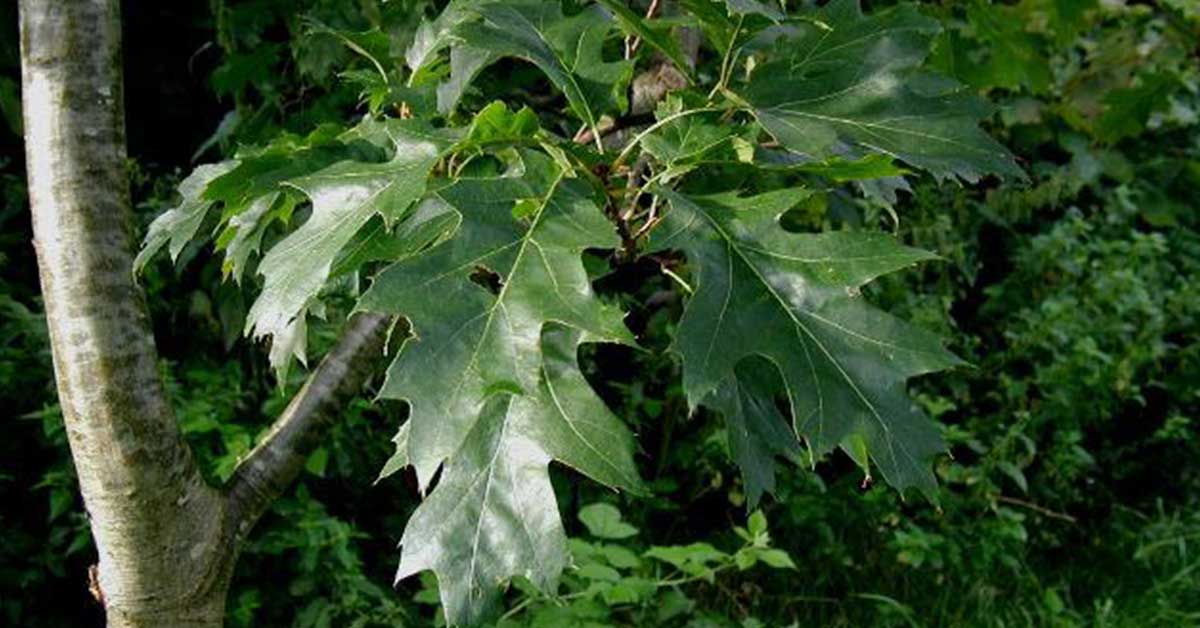If you love tall oak trees that have a rich red, almost burgundy autumn leaf color, then the northern red oak tree is the tree for you. These trees are just the perfect addition to any property that needs a splash of red oak leaf color every fall. In this article, we’re going to go over everything you need to know to successfully grow these amazing, sturdy oak trees.
Growing northern red oak trees
Before we get to planting a northern red oak tree, it’s best to know a little bit about the tree. These are the fast facts on these wonderful oak trees:
- Latin name: Quercus rubra
- Other names: common red oak, eastern red oak, mountain red oak, and gray oak.
- Native to: Eastern and central United States and southeast and south-central Canada
- Invasiveness: Potentially
- Sun: Full sun or part sun
- Soil: Acidic, clay, loamy, moist, sandy, and well-drained soils
- Hardiness zone: 3-8
- When to plant: Spring or Fall
- Spacing: 10 feet
- Plant height: 75 feet
- Time to maturity: 20 years
- Container friendly: No
- Fertilizer: 12-4-8 or 12-6-6
- Deer resistant: No
- Fall color: Dark red, burgundy
The northern red oak tree is a tall, sturdy tree native to Eastern and central United States and southeast and south-central Canada. They were first introduced to Europe in the 1700s and are considered potentially invasive, so if planting outside of their native range, always plant with care. These trees need a minimum of 6 hours of direct sunlight every day in order to grow well, which puts them right on the borderline of part sun and full sun. Full sun is recommended, but you may make the cut if you don’t quite have full sun.
They don’t require special soil to grow. They can deal with a wide range of soils, ranging from acidic, clay, loamy, moist, sandy, and well-drained soils. Saplings can be planted outdoors in spring or fall in hardiness zones 3 through 8. If you opt to plant multiple trees, they should be spaced out by at least 10 feet. These trees grow very tall, up to 75 feet. They reach their maximum height after about 20 years of growth.
Young red oak trees can be provided a 12-4-8 or 12-6-6 NPK fertilizer to help their growth. These trees unfortunately are not suitable for containers and are not deer resistant. They produce a deep red, almost burgundy autumn foliage.
Read More: 10 Trees With Red Fall Leaves
Water
Red oak trees will need no supplemental water once it’s established and growing, but for the first few years after planting it, you’ll want to provide your sapling with occasional deep watering, especially if you live in an area where summer rainfall is scarce. Established trees will need no extra water.
Sunlight
Red oak trees need a minimum of 6 hours of direct sunlight every day in order to grow well, which puts them right on the borderline of part sun and full sun. Full sun is recommended, but you may make the cut if you don’t quite have full sun.
Soil
Red oak trees don’t require special soil to grow. They can deal with a wide range of soils, ranging from acidic, clay, loamy, moist, sandy, and well-drained soils. Whatever soil you have should be just fine for a red oak tree. Definitely no reason to overthink it!
Fertilizing
Young red oak trees can benefit from an NPK fertilizer of 12-4-8 or 12-6-6. Once the tree has become a bit more established, no additional fertilizer will be required.
Planting northern red oak saplings
You can plant your red oak tree pretty much any time in the spring or fall. Planting the tree is straight forward. Simply dig a hole as deep as the root ball of the tree and twice as wide. Place your sapling in the hole and fill the widened section of the hole with a soil and compost mixture. Once the hole is completely filled, give it an extremely thorough watering, ensuring that the entire area is well watered. Use a bark mulch to help keep the roots cool and damp as it gets established. Routinely give a thorough watering until established.
Growing northern red oak trees in containers
Red oak trees are simply not suitable for growing in a container. They can grow to a very large size and will eventually become root bound and die, even if you’ve planted it in a very large container. If you want to grow a red oak in a container for a few years, that’s fine. But don’t expect it to live very many years or grow all that large.
Propagating northern red oak trees
If you want to plant your very own northern red oak tree, it’s as simple as collecting some acorns and planting them. Well, there’s a bit more to it than that. You can’t just plant an acorn and expect it to start growing right away. Acorns need to be stratified for at least 60 days before they will germinate. Stratification is the process of exposing it to cool temperatures.
You can mimic natural stratification by placing your acorns in a damp cloth in the refrigerator for 2 months. After 60 days, your acorn should be about ready to germinate and can be moved to a container of potting soil. It is highly recommended that you attempt to germinate at least 10 acorns as not all of them will be viable. Once ready, your sapling can be planted in the ground any time in the spring or fall.


